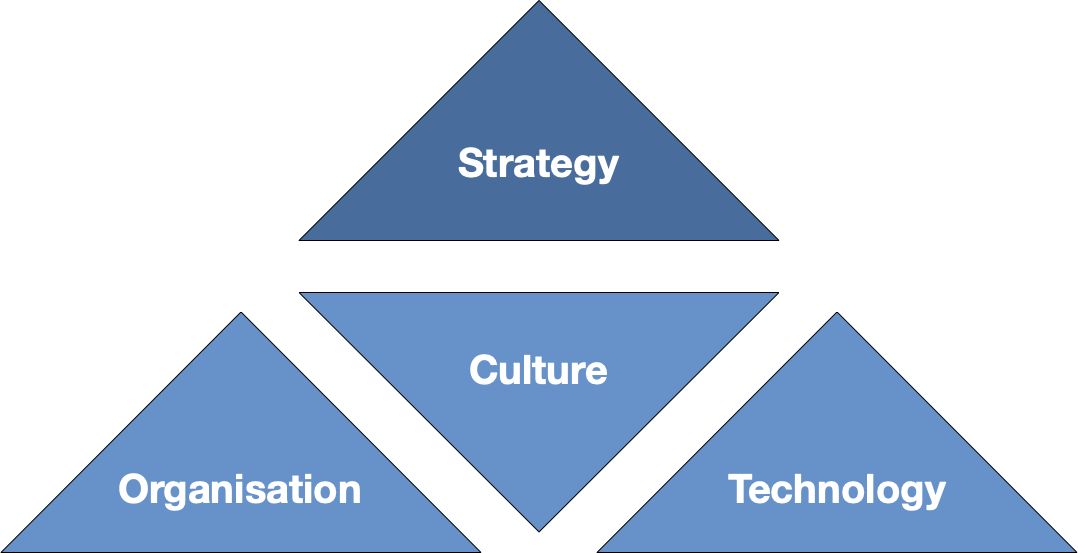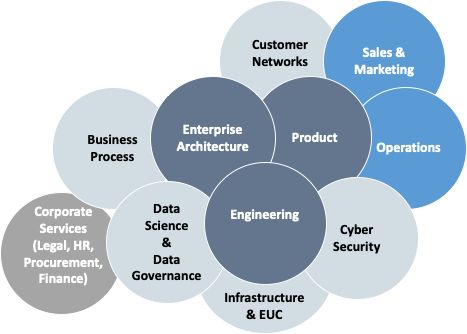Why Digital Transformation Fails
Many organisational change initiatives fail. We discuss hostility and indifference, encumbrance by the past, making the true commitment, a failure to iterate, starting with technology first, and, biggest of all, strategy execution. Knowing the reasons for failure informs what to do to succeed.

It's no secret that the majority of organisational change initiatives fail. Let's say that only one-third deliver measurable value. When it comes to digital transformations only 1 in 20 exceed expection.
Why is this? We'll discuss:
- Hostility and indifference
- Encumbered by the past
- Making the commitment
- Failure to iterate
- Technology first
- Strategy execution
... and then set out what to do to increase your chance of success.
Hostility and indifference
Failure of initiatives causes corporate leadership to be somewhat antagonistic to the very term 'digital transformation', the hype/frustration around it, and at the vagueness of what it is. Some of this hostility is aimed at change in general, and the agitation it causes to their workforce. The natural state of the world tends towards disorder and business is no different; the longer a company exists the more disordered it becomes, unless it receives the increasing amounts of attention it needs to stabilise. Stéphane Garelli talks eloquently on this subject in Why you will probably live longer than most big companies.
Indifference is another reason why digital transformation has a bad press. There is so much to do in a complex organisation, that it's easier to get on with what we know, and to focus on our bonus-triggering targets.
Encumbered by the past
A major reason for failure of digital transformation is that the world has moved on and many leaders have not realised the extent to which it has done so. Companies are saddled with cost structures and value chains from an earlier era. And we're not just talking about the need to stay relevant as markets, consumers and technology evolve, its that the way the company has always operated weighs the company down, and the usual change methods don't work. Here's why:
Overload. For many, every day brings the next imperative in the corporate cycle of difficult, routine, or monotonous tasks. Monday meetings, Wednesday steering, Friday reporting, monthly newsletter, the planning cycle, the quarterly budget review, staff target setting, staff appraisals, departmental town hall, as well as the product strategy meeting, the process documentation revision sign-off, the 6-weekly meet with the Union, briefing those who hold the company debt. And then there are the actual operational matters to resolve.
Correlation. Nearly all corporate activities have an element of dependence and consequence on each other. The result of an action or change in one area will be felt elsewhere in the company; possibly just the flutter of a butterfly's wings, possibly the stampede of a herd of elephants. These inter-relationships are rarely understood and resulting impact isn't easily predictable.
Unknown. Many organisations, whether they realise it or not, have very significant knowledge and documentation deficits. These are not only business operational and technology matters, but transferred legal and regulatory challenges. Low levels of awareness of Exec accountability for these gaps and an historic lack of context as to why decisions have been made, result in a poor corporate memory. This amount of missing information makes it difficult to implement change with any certainty.
The result is that daily operations are complicated, complex or chaotic, and this drags on efforts to transform. The intention to make a simple change proves difficult. Pulling one lever makes three unknown consequences emerge. When each of these is subsequently investigated, two offer only unpalatable options to move forward, and the third produces three more explosions.
Traditional companies are encumbered by their past; their organisational structures, their behavioural patterns and their technical debt.
Making the commitment
Let's assume that the Exec have discussed the need for change over a period of time and now say that they understand and agree to the vision presented. Great!
Or is it? How deeply-felt is that understanding? Each person will have a different level of interpretation of what has been discussed, a subtly different view of what the future will look like. They will have a different understanding of the breadth and depth of what will change, and a different threshold of acceptance of change than their colleagues.
What is within personal tolerance for one Exec member may not be for another, who may feel that the amount of disruption caused by the transformation would encounter too much shop-floor resistance, or would adversely affect revenue. Worse, they may not realise these points until the work is well underway, and then try to derail work in progress.
How does the Exec work together as a team? Are they a team, or are they masters of their own functional silos, and, whilst in agreement in principle, will object when the change affects their fiefdom or ability to execute? How strong is the CEO in resolving any reticence of Exec members, making them toe the line and taking the lead in championing the vision?
These are all common failure points. Understanding and agreeing to the proposal for your company transformation is not the same as committing to do whatever it takes to succeed, even if the details must be taken on trust for now.
A digital transformation is a major company endeavour that needs deep commitment, proven shared understanding of the proposed end-outcomes and the method of getting there, and the time to build support across all stakeholders.
Trying to start before sufficient people understand the why and the how is a recipe for failure. You need to track every concern and keep a close eye on how and when they are resolved.
Commitment needs to be unequivocal. Once the Exec are truly on board, then they need to commit to do whatever it takes to succeed, including those things that we don't know about yet, but are sure to service. This commitment includes gaining a similar commitment from C-1, their direct reports.
For the avoidance of doubt, the commitment also includes the funding. It's OK to give the usual 3-months to build up to this level of commitment, and it's OK to set achievement gates to unlock the next round of funding, but once the decision is made then an outline funding commitment for the whole journey must come with it.
Failure to Iterate
Traditional companies have tried and tested governance structures, mature portfolio management and Capex approval mechanisms.
Coming up with a vision, building a business case, approving that same business case and then having a programme team work on a detailed plan for the next two years is almost certain to result in transformation failure.
Agile leadership is needed. It is almost impossible to build a plan that predicts what needs to be done when. Actions need to be focused on delivering the intended results, and these actions will vary on circumstance. For example, staff may need to be incentivised to take risks, to take responsibility and to share knowledge. At each point, they or their managers may be tempted to revert to the old ways of working, so annual targets may need to be revised mid-year.
The trick is to have a clear strategic direction and to break the endeavour into many smaller initiatives, each of which have short-term objectives and measurable success factors, aligned to the strategic intent.
We explore how you can do this with Squads working in Sprints in The Three Laws.
You can control risk by funding the journey by Sprints, incrementally instantiating change. This way, you can let the transformation journey evolve as it unfolds, avoiding the temptation to create a plan for governance's sake without enough known factors.
This approach can be scary for the time-served Exec: hierarchical organisational structures dissolve, decisions are put in the hands of self-directing small teams, signing off business cases on the basis of a waterfall plan disappear. Don't worry though, Aston Beck can help you through this uncertainty and help you reimagine and reinvent your business.
As your people learn from each sprint, you'll notice that you unlock value at a greater speed. In turn, these wins give your teams energy and momentum, and mitigates against change fatigue.
Technology First
There is a misunderstanding that digital transformation must be what IT do, right? Not quite. 'digital' refers to the agility and flexibility of a technical solution, but in the context that it is applied to corporate operations.
And IT don't have the greatest of reputation at present, so we wouldn't want to trust anything big to them... Fair point, but they probably have that reputation because they have been treated as an arms-length contractor, not an integral part of the organisation.
And, that hotshot Chief Digital Officer we hired in 2015 spent millions on new tech toys that haven't delivered any business value. Was there an agreed strategy? Who managed them?
Too many digital transformation programmes are launched on the basis that its the technology that will drive the transformation. To an extent, that is true, in that technology enables the changes needed, and provides the tooling for efficient operations, but there can be no chance of success unless digital transformation is a whole-company initiative, involving organisational redesign and behavioural change.
IT modernisation to build capability and scale in the Cloud is worthy objective, but large-scale work consumes capital, time, exhausts appetite for change and confuses decision making through a lack of obvious business benefit. Digital transformation usually requires change in business procedures and team-members' roles and responsibilities, to align with change in the technology. These amendments prolong a technology-first approach, and do nothing for IT's reputation. To put technology first is an almost certain path to failure.
Starting digital transformation with expensive legacy-replacement activities won't achieve strategic intent. Instead success comes from iterating technology upgrades along with organisational and behavioural change, starting with understanding how business operations need to improve to deliver more / different value to customers and employees. This way Execs understand why they have to change their operating model and way of doing business, and can see the monetary benefit. Better still, rather than replatforming applications on new, Cloud infrastructure, a well-considered enterprise architecture and product management capability will allow Cloud-native systems to be engineered, to bring capability right up to date.
Strategy Execution
Strategy execution is the number 1 problem facing Fortune 750 businesses globally (before Covid-19) - MIT Sloan.
$1m is wasted every minute globally due to the poor implementation of strategy, which amounts to almost $5bn wasted every day, or $2trn a year - PMI Research
Organisations find it very difficult to consistently track the outcomes of major investment and the improvement on their objectives and KPIs. As a result, it is difficult for leadership teams to determine value for money and to know if they are executing their strategic objectives in the most efficient way. This means that there is very little objective feedback available to support the return on investment needed for a significant digital transformation, and, for all the reasons outlined earlier in the post, Execs can lose faith in the initiative.
So, how do you succeed?
The imperative to embark or continue a digital transformation remains. Aston Beck's experience suggests that there is a need to focus on:

An overall Strategy which sets out the work needed on
- Organisation
- Culture
- Technology.
Organisational Restructuring. In simple terms, move from a hierarchical, function-based structure to a value-stream based structure, with cross-function resources focused around each corporate products. Set up small teams who are self-directing and encouraged to constantly explore how to deliver value to the end-customer. Move to make each product opex funded with ring-fenced teams.
Cultural Change is the hardest part of digital transformation, empowering staff to continually challenge the status quo, experiment often, and get comfortable with failure. Encourage new behaviours aligned to being a customer-centric organisation and working in a cross-functional manner, with a mandate to take responsibility. Introduce by example, rather than telling them what their behaviour should be.
Technology. Move the technology estate to the Cloud. Digitise data, digitalise processes and roles. Provide staff with digital tools to help them perform their work at scale and distance, to innovate and to automate the transactional and repetitive tasks.
Strategy. As well as overall vision for the three points above, the strategy must cover corporate capability in each key area:

Needless to say, Aston Beck have a clear view on what your strategy should be to implement the full breadth and depth of digital transformation.
In support of strategy execution, it is essential to have a clear way of measuring progress against intent and to show the contribution value over time as outcomes are met.
Traditional project portfolio management (PPM) tools can be dumping grounds of delivery activity which rarely align delivery to strategic objectives. They rarely give the leadership team clear insight how objectives will be achieved.
This makes it:
- impossible to tell if the investment in the delivery portfolio is “the right” investment
- very challenging to measure strategic value for money
- difficult to know what to prioritise strategically, especially given the agility needed with the iterative approach.
Nevertheless, we must start our journey using current practices. Aston Beck use a transformation management office (TMO) approach to help our clients execute on their strategic objectives faster and more effectively, with more transparency and governance. We provide insight into how strategic value is being banked with every KPI met.
